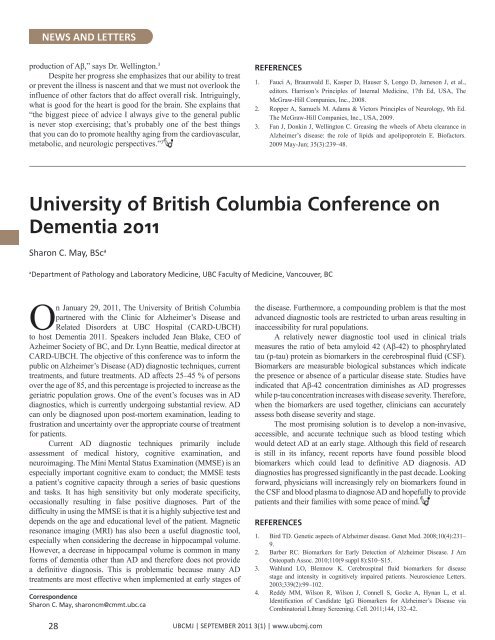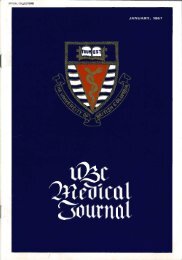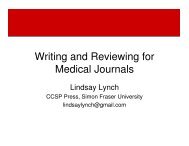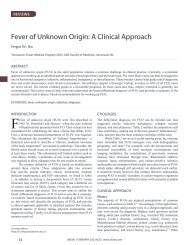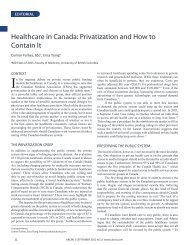Download full PDF - UBC Medical Journal
Download full PDF - UBC Medical Journal
Download full PDF - UBC Medical Journal
Create successful ePaper yourself
Turn your PDF publications into a flip-book with our unique Google optimized e-Paper software.
NEWS AND LETTERS<br />
production of Aβ,” says Dr. Wellington. 3<br />
Despite her progress she emphasizes that our ability to treat<br />
or prevent the illness is nascent and that we must not overlook the<br />
influence of other factors that do affect overall risk. Intriguingly,<br />
what is good for the heart is good for the brain. She explains that<br />
“the biggest piece of advice I always give to the general public<br />
is never stop exercising; that’s probably one of the best things<br />
that you can do to promote healthy aging from the cardiovascular,<br />
metabolic, and neurologic perspectives.” 3<br />
REFERENCES<br />
1. Fauci A, Braunwald E, Kasper D, Hauser S, Longo D, Jameson J, et al.,<br />
editors. Harrison’s Principles of Internal Medicine, 17th Ed, USA, The<br />
McGraw-Hill Companies, Inc., 2008.<br />
2. Ropper A, Samuels M. Adams & Victors Principles of Neurology, 9th Ed.<br />
The McGraw-Hill Companies, Inc., USA, 2009.<br />
3. Fan J, Donkin J, Wellington C. Greasing the wheels of Abeta clearance in<br />
Alzheimer’s disease: the role of lipids and apolipoprotein E. Biofactors.<br />
2009 May-Jun; 35(3):239–48.<br />
University of British Columbia Conference on<br />
Dementia 2011<br />
Sharon C. May, BSc a<br />
a<br />
Department of Pathology and Laboratory Medicine, <strong>UBC</strong> Faculty of Medicine, Vancouver, BC<br />
On January 29, 2011, The University of British Columbia<br />
partnered with the Clinic for Alzheimer’s Disease and<br />
Related Disorders at <strong>UBC</strong> Hospital (CARD-<strong>UBC</strong>H)<br />
to host Dementia 2011. Speakers included Jean Blake, CEO of<br />
Azheimer Society of BC, and Dr. Lynn Beattie, medical director at<br />
CARD-<strong>UBC</strong>H. The objective of this conference was to inform the<br />
public on Alzheimer’s Disease (AD) diagnostic techniques, current<br />
treatments, and future treatments. AD affects 25–45 % of persons<br />
over the age of 85, and this percentage is projected to increase as the<br />
geriatric population grows. One of the event’s focuses was in AD<br />
diagnostics, which is currently undergoing substantial review. AD<br />
can only be diagnosed upon post-mortem examination, leading to<br />
frustration and uncertainty over the appropriate course of treatment<br />
for patients.<br />
Current AD diagnostic techniques primarily include<br />
assessment of medical history, cognitive examination, and<br />
neuroimaging. The Mini Mental Status Examination (MMSE) is an<br />
especially important cognitive exam to conduct; the MMSE tests<br />
a patient’s cognitive capacity through a series of basic questions<br />
and tasks. It has high sensitivity but only moderate specificity,<br />
occasionally resulting in false positive diagnoses. Part of the<br />
difficulty in using the MMSE is that it is a highly subjective test and<br />
depends on the age and educational level of the patient. Magnetic<br />
resonance imaging (MRI) has also been a useful diagnostic tool,<br />
especially when considering the decrease in hippocampal volume.<br />
However, a decrease in hippocampal volume is common in many<br />
forms of dementia other than AD and therefore does not provide<br />
a definitive diagnosis. This is problematic because many AD<br />
treatments are most effective when implemented at early stages of<br />
Correspondence<br />
Sharon C. May, sharoncm@cmmt.ubc.ca<br />
the disease. Furthermore, a compounding problem is that the most<br />
advanced diagnostic tools are restricted to urban areas resulting in<br />
inaccessibility for rural populations.<br />
A relatively newer diagnostic tool used in clinical trials<br />
measures the ratio of beta amyloid 42 (Aβ-42) to phosphrylated<br />
tau (p-tau) protein as biomarkers in the cerebrospinal fluid (CSF).<br />
Biomarkers are measurable biological substances which indicate<br />
the presence or absence of a particular disease state. Studies have<br />
indicated that Aβ-42 concentration diminishes as AD progresses<br />
while p-tau concentration increases with disease severity. Therefore,<br />
when the biomarkers are used together, clinicians can accurately<br />
assess both disease severity and stage.<br />
The most promising solution is to develop a non-invasive,<br />
accessible, and accurate technique such as blood testing which<br />
would detect AD at an early stage. Although this field of research<br />
is still in its infancy, recent reports have found possible blood<br />
biomarkers which could lead to definitive AD diagnosis. AD<br />
diagnostics has progressed significantly in the past decade. Looking<br />
forward, physicians will increasingly rely on biomarkers found in<br />
the CSF and blood plasma to diagnose AD and hope<strong>full</strong>y to provide<br />
patients and their families with some peace of mind.<br />
REFERENCES<br />
1. Bird TD. Genetic aspects of Alzheimer disease. Genet Med. 2008;10(4):231–<br />
9.<br />
2. Barber RC. Biomarkers for Early Detection of Alzheimer Disease. J Am<br />
Osteopath Assoc. 2010;110(9 suppl 8):S10–S15.<br />
3. Wahlund LO, Blennow K. Cerebrospinal fluid biomarkers for disease<br />
stage and intensity in cognitively impaired patients. Neuroscience Letters.<br />
2003;339(2):99–102.<br />
4. Reddy MM, Wilson R, Wilson J, Connell S, Gocke A, Hynan L, et al.<br />
Identification of Candidate IgG Biomarkers for Alzheimer’s Disease via<br />
Combinatorial Library Screening. Cell. 2011;144, 132–42.<br />
28<br />
<strong>UBC</strong>MJ | SEPTEMBER 2011 3(1) | www.ubcmj.com


